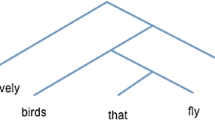Abstract
I discuss a stochastic model of language learning and change. During a syntactic change, each speaker makes use of constructions from two different idealized grammars at variable rates. The model incorporates regularization in that speakers have a slight preference for using the dominant idealized grammar. It also includes incrementation: The population is divided into two interacting generations. Children can detect correlations between age and speech. They then predict where the population’s language is moving and speak according to that prediction, which represents a social force encouraging children not to sound out-dated. Both regularization and incrementation turn out to be necessary for spontaneous language change to occur on a reasonable time scale and run to completion monotonically. Chance correlation between age and speech may be amplified by these social forces, eventually leading to a syntactic change through prediction-driven instability.
Similar content being viewed by others
References
Adger D. (2003) Core syntax: A minimalist approach. Oxford University Press, Oxford
Bresnan, J., & Nikitina, T. (2007). The gradience of the dative alternation. In L. Uyechi, & L. H. Wee (Eds.), Reality exploration and discovery: Pattern interaction in language and life. Stanford: CSLI Publiscations. http://www.stanford.edu/~bresnan/publications/index.html.
Briscoe E. J. (2000) Grammatical acquisition: Inductive bias and coevolution of language and the language acquisition device. Language 76(2): 245–296
Briscoe, E. J. (2002). Grammatical acquisition and linguistic selection. In E. J. Briscoe (Ed.), Linguistic evolution through language acquisition: Formal and computational models. Cambridge: Cambridge University Press. http://www.cl.cam.ac.uk/users/ejb/creo-evol.ps.gz.
Ellegård A. (1953) The auxiliary do: The establishment and regulation of its use in English, Gothenburg studies in English. Almqvist and Wiksell, Stockholm
Gibson E., Wexler K. (1994) Triggers. Linguistic Inquiry 25: 407–454
Gold E. M. (1967) Language identification in the limit. Information and Control 10: 447–474
Hudson Kam C. L., Newport E. L. (2005) Regularizing unpredictable variation: The roles of adult and child learners in language formation and change. Language Learning and Development 1(2): 151–195
Kirby S. (2001) Spontaneous evolution of linguistic structure: An iterated learning model of the emergence of regularity and irregularity. IEEE Transactions on Evolutionary Computation 5(2): 102–110
Komarova N. L., Niyogi P., Nowak M. A. (2001) The evolutionary dynamics of grammar acquisition. Journal of Theoretical Biology 209(1): 43–59
Kroch A. (1989) Reflexes of grammar in patterns of language change. Language Variation and Change 1: 199–244
Labov W. (1994) Principles of linguistic change: Internal factors. Blackwell, Cambridge, MA
Labov W. (2001) Principles of linguistic change: Social factors. Blackwell, Cambridge, MA
Mitchener W. G. (2003) Bifurcation analysis of the fully symmetric language dynamical equation. Journal of Mathematical Biology 46: 265–285. doi:10.1007/s00285-002-0172-8
Mitchener W. G. (2007) Game dynamics with learning and evolution of universal grammar. Bulletin of Mathematical Biology 69(3): 1093–1118. doi:10.1007/s11538-006-9165-x
Mitchener, W. G. (2009a). Mean-field and measure-valued differential equation models for language variation and change in a spatially distributed population, submitted.
Mitchener, W. G. (2009b). A stochastic model of language change through social structure and prediction-driven instability, submitted.
Mitchener W. G., Nowak M. A. (2003) Competitive exclusion and coexistence of universal grammars. Bulletin of Mathematical Biology 65(1): 67–93. doi:10.1006/bulm.2002.0322
Mitchener W. G., Nowak M. A. (2004) Chaos and language. Proceedings of the Royal Society of London, Biological Sciences 271(1540): 701–704. doi:10.1098/rspb.2003.2643
Niyogi P. (1998) The informational complexity of learning. Kluwer Academic Publishers, Boston
Niyogi P., Berwick R. C. (1996) A language learning model for finite parameter spaces. Cognition 61: 161–193
Niyogi, P., & Berwick, R. C. (1997). A dynamical systems model for language change. Complex Systems, 11, 161–204, ftp://publications.ai.mit.edu/ai-publications/1500-1999/AIM-1515.ps.Z.
Nowak M. A., Komarova N. L., Niyogi P. (2001) Evolution of universal grammar. Science 291(5501): 114–118
Nowak M. A., Komarova N. L., Niyogi P. (2002) Computational and evolutionary aspects of language. Nature 417(6889): 611–617
Radford A. (2004) Minimalist syntax: Exploring the structure of English. Cambridge University Press, Cambridge
Tesar B., Smolensky P. (2000) Learnability in optimality theory. MIT Press, Cambridge, MA
Warner A. (2005) Why DO dove: Evidence for register variation in early modern English negatives. Language Variation and Change 17: 257–280. doi:10.1017/S0954394505050106
Yang C. D. (2002) Knowledge and learning in natural language. Oxford University Press, Oxford
Author information
Authors and Affiliations
Corresponding author
Rights and permissions
About this article
Cite this article
Mitchener, W.G. A Mathematical Model of Prediction-Driven Instability: How Social Structure Can Drive Language Change. J of Log Lang and Inf 20, 385–396 (2011). https://doi.org/10.1007/s10849-011-9136-y
Published:
Issue Date:
DOI: https://doi.org/10.1007/s10849-011-9136-y




